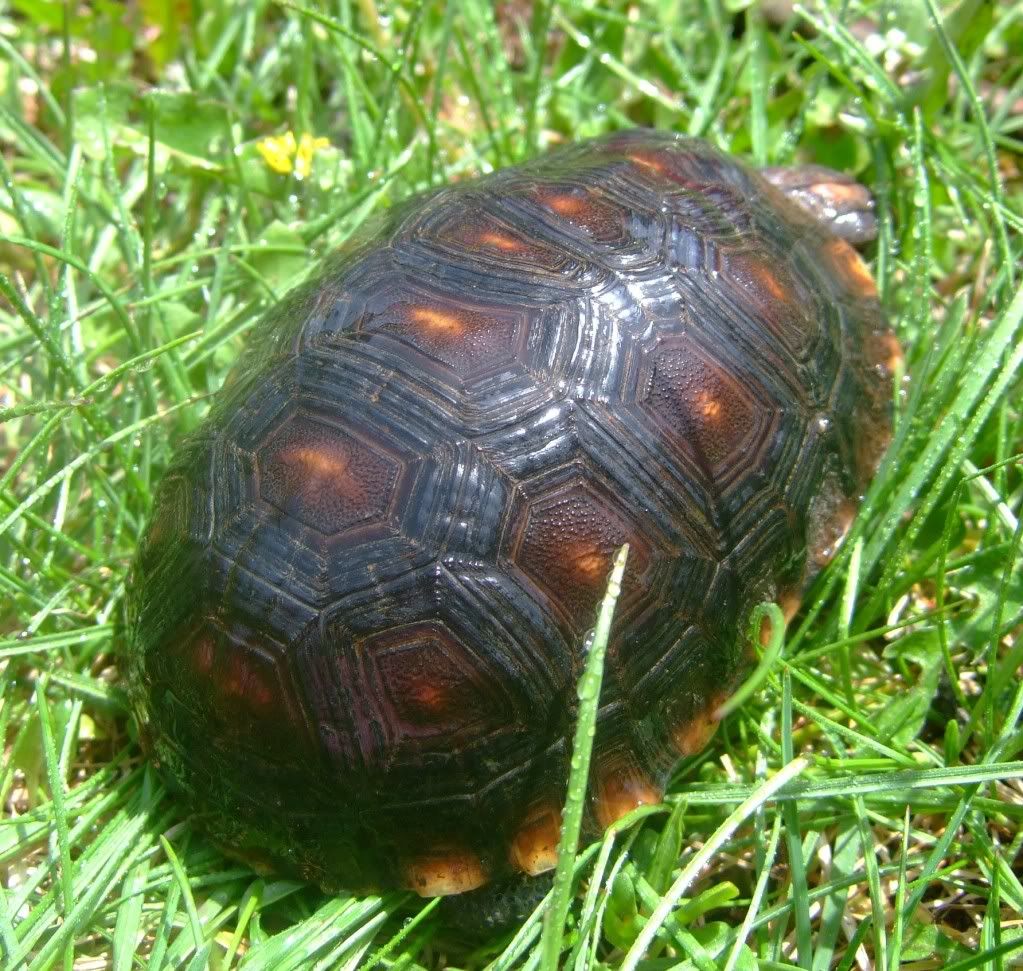This female has produced hatchlings from Northern males as recent as last year. She produced with little consistency ( from the Northern males ) although she has always been consistent with her laying cycles since early '06. [ meaning she had low hatch rate ]

"Most" of her hatchlings from as recent as '00 had both Northern and Brazilian characteristics - the Brazilian characteristics most likely from her. DUH!
Although I [ and those breeders that I communicate with most ] don't take to "speculation".. we figure that she carried viable sperm for those TWO YEARS - read on...
In 8/08 she was separated from the cursed Northern males and was only with the only potential mature male.

He has been with me as the "Alpha" male since he was slight 7" SCL in '05 -

As you may notice he has questionable? "genes" going on with the carapace abnormalities!
A few examples of the "hybrid" hatchlings -


And from as recent as late '09 - early '10 eggs -



"Did he sneak in there some on the above hatchling"?
Not what I would actually call a "runt' [ common-sized in my camp ]
Initially very little PALE red/pink with a lot of black on them.
***** PHASE TWO *****

The above pic is from 8/16/00. The next dozen eggs from that and two other clutches produced "0" hatchlings! We wondered [ as least I did ] if the male was shooting blanks!
THEN the first Nov. '10 egg hatched -

And the next 3 have had black/pale-yellow colors.. and undeveloped plastrons and/or enlarged yolk-sacs -


To my knowledge this male has contributed little if any prior to this years hatchlings [ Aug. '10 - Dec. '10 eggs ]. So there is not the possibilty of having prior "normal" colors that went bad because of environment, diet, timing, etc. because there were none.
Again IF I were to "speculate".. it would be that she contributes the colors and he contributes the black - no that's not talking out of both sides of my mouth!
Only time will tell.....
NERD

"Most" of her hatchlings from as recent as '00 had both Northern and Brazilian characteristics - the Brazilian characteristics most likely from her. DUH!
Although I [ and those breeders that I communicate with most ] don't take to "speculation".. we figure that she carried viable sperm for those TWO YEARS - read on...
In 8/08 she was separated from the cursed Northern males and was only with the only potential mature male.

He has been with me as the "Alpha" male since he was slight 7" SCL in '05 -

As you may notice he has questionable? "genes" going on with the carapace abnormalities!
A few examples of the "hybrid" hatchlings -


And from as recent as late '09 - early '10 eggs -



"Did he sneak in there some on the above hatchling"?
Not what I would actually call a "runt' [ common-sized in my camp ]
Initially very little PALE red/pink with a lot of black on them.
***** PHASE TWO *****

The above pic is from 8/16/00. The next dozen eggs from that and two other clutches produced "0" hatchlings! We wondered [ as least I did ] if the male was shooting blanks!
THEN the first Nov. '10 egg hatched -

And the next 3 have had black/pale-yellow colors.. and undeveloped plastrons and/or enlarged yolk-sacs -


To my knowledge this male has contributed little if any prior to this years hatchlings [ Aug. '10 - Dec. '10 eggs ]. So there is not the possibilty of having prior "normal" colors that went bad because of environment, diet, timing, etc. because there were none.
Again IF I were to "speculate".. it would be that she contributes the colors and he contributes the black - no that's not talking out of both sides of my mouth!
Only time will tell.....
NERD



